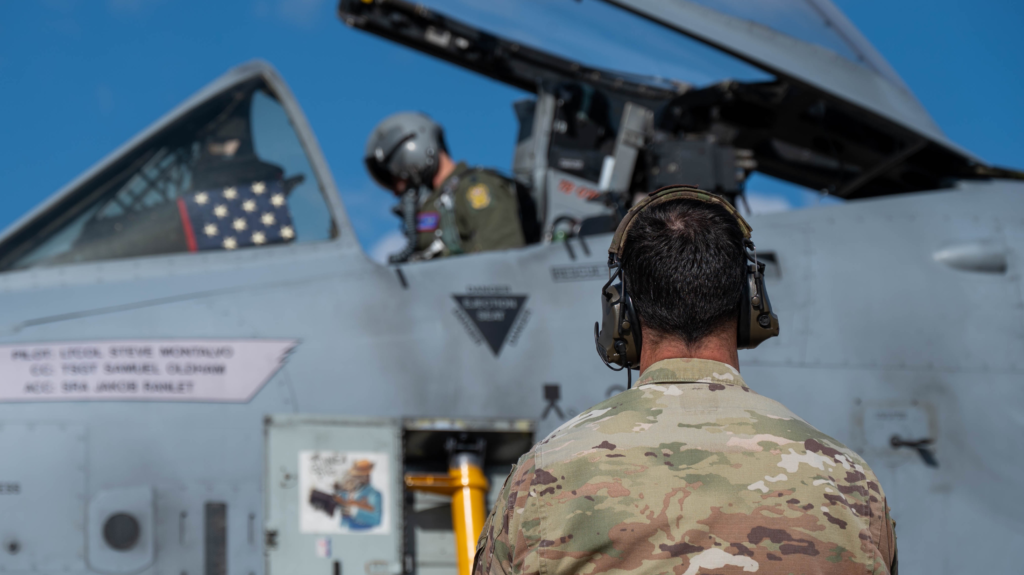Sept. 23, 2025, is a milestone that highlights the U.S. Air Force’s capacity death spiral. On that day, the Maryland Air National Guard (ANG) inactivated the 104th Fighter Squadron, making Maryland the only state without an ANG flying unit. The reason is simple: For too many years, Air Force funding shortfalls have driven service leaders to retire more aircraft than they can replace through new acquisition. With demand for Air Force airpower at record levels, remaining aircraft and crews are stretched thin.
The Air Force has passed the point where more cannot be done with less. The Trump administration and Congress need to sufficiently resource the Air Force. It has been underfunded for over three decades. Left unchecked, what happened to the 104th Fighter Squadron will be repeated elsewhere around the nation and at key Air Force bases abroad.
Proof of the Air Force’s capacity crunch is in the numbers. In fiscal 2025, the service sought to divest 250 aircraft but only procure 91 new ones. In the fiscal 2026 budget submission, they requested to retire 340 aircraft but only buy 76 replacement aircraft. Bombers and fighters took the brunt of these cuts in the decades following the Cold War. Air Force aircraft inventories today stand at half of what they were when the Berlin Wall fell. Fighters are now undergoing a new round of cuts because aircraft procured during President Ronald Reagan’s build-up during the 1980s are now at the end of their service lives.
From a pragmatic vantage, this is why in 2022 the Air Force sunset F-15C/Ds assigned to the 18th Fighter Wing at Kadena Air Base in Japan without permanently assigned backfill aircraft. This is one of the most important geostrategic locations in the world given its proximity to China and the Air Force now rotates other units through this location to maintain presence. Permanently assigned aircraft are years away given slow buy rates.
It is also why the Air Force Reserve is sunsetting nearly 50% of its fighter capacity between now and 2030 due to a lack of backfill aircraft to replace retiring older types. Affected locations include Homestead Air Reserve Base, Florida; Davis-Monthan Air Force Base, Arizona; Whiteman Air Force Base, Missouri; and Moody Air Force Base, Georgia. Also on this list is the Air Force Reserve aggressor squadron at Nellis Air Force Base, Nevada, which is crucial element of front-line training for the entire force.
As a result of the Air Force’s capacity woes, the service increasingly lacks the aircraft necessary to execute a campaign for any length of time if called upon to do so. Operation Midnight Hammer, the U.S. military’s strikes on Iranian nuclear facilities, was a magnificent demonstration of Air Force capabilities, but it was a one-off event. The service could not have accomplished the same strike package the next day. To put it in historic terms, Midnight Hammer mirrored the Doolittle Raid — an impressive achievement, but far from a war-winning demonstration of decisive combat power at scale. That came later in WWII, after the U.S. spooled up its industrial base and training pipeline to facilitate the Combined Bomber Offensive — the Allies’ relentless and costly campaign of sending wave after wave of bombers to strike Axis industrial sites in Europe — and mass air operations around the world. Numbers matter.
As an indicator of the serious gap between the Air Force we need and the Air Force as budgeted, service leaders have long said that they need to procure 72 fighters per year just to stop the decline in fighter average age. The fiscal 2026 budget requested just 45. That’s why units will keep closing — it is simple math.
The solution to this challenge is quite simple: The Air Force needs to be sufficiently resourced to buy combat aircraft at scale. Anticipating this recapitalization window, service leaders and industry spent the past few decades developing next generation aircraft like the F-35, F-15EX, F-47, Collaborative Combat Aircraft, B-21, E-7, EA-37B, KC-46, T-7, MH-139 and HH-60W. The value of these programs will only be realized if they are rapidly procured in high volume. Past leaders, like President Reagan, understood the need to invest in decisive airpower. The mantle now falls on President Donald Trump and Congress.
The need for these aircraft is not theoretical. With China pressing hard in the Pacific, Russia at war in Ukraine, Iran still committed to destabilizing the Middle East, North Korea standing as a very dangerous nuclear adversary and homeland defense an increasingly crucial mission given modern threats, the need for Air Force airpower is at a historic high. Adversaries know the Air Force is stretched thin and this undoubtedly enters their calculus as they decide how to challenge U.S. interests around the world.
Losing the deterrent edge stands as one of the biggest risks facing the nation. It is always in America’s interest to secure its interests by harnessing peace through strength. That requires a renewed investment in Air Force capacity.
Douglas A. Birkey is the executive director for the Mitchell Institute for Aerospace Studies.


